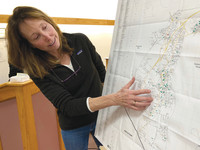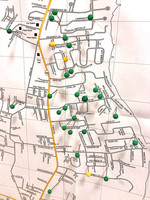Portsmouth Police, scientist: Stop leaving food for coyotes
More sightings reported in densely populated neighborhoods
PORTSMOUTH — The pins told the story.
Stuck onto a street map of Portsmouth displayed at Town Hall Tuesday night, a cluster of them showed where the biggest concentration of coyote …
This item is available in full to subscribers.
Please log in to continue |
Register to post eventsIf you'd like to post an event to our calendar, you can create a free account by clicking here. Note that free accounts do not have access to our subscriber-only content. |
Day pass subscribers
Are you a day pass subscriber who needs to log in? Click here to continue.
Portsmouth Police, scientist: Stop leaving food for coyotes
More sightings reported in densely populated neighborhoods
PORTSMOUTH — The pins told the story.
Stuck onto a street map of Portsmouth displayed at Town Hall Tuesday night, a cluster of them showed where the biggest concentration of coyote sightings have been reported in town over the past year — on the east side of East Main Road, between Hargraves Drive to the north and Vanderbilt Lane to the south.
That’s a shift from where the animals have generally been spotted before, said police, as they’re now being seen in more densely populated neighborhoods and not just in open fields or along the island’s perimeter.
“I know there’s a lot of interest in the community about recent coyote sightings. There have been neighborhoods that have recently seen coyotes for first time,” Police Chief Thomas Lee told a capacity audience at the start of the informational meeting he organized. “Before, we just heard about the southern section and Common Fence Point.”
The message from wildlife scientists and police was clear Tuesday night: The most effective way of reducing the coyote population is to take away their manmade sources of food.
“Coyotes should be really easy to coexist safely with us,” said Numi Mitchell, lead scientist of the Narragansett Bay Coyote Study, which traps and collars coyotes and tracks their movements around the area through GPS. “We don’t need to shoot coyotes to bring their numbers down. If we could manage the amount of food that goes to coyotes somehow, we can manage them.”
Studies have shown that coyotes “don’t like residential areas at all” because they usually lack food resources, she said. “Coyotes should reach their saturation in natural areas because that’s where the food is,” she said.
But that changes when residents inadvertently or purposely leave food outside. These sources can include food scraps tossed out the door, pet food left outside, fallen pears or apples that are not collected, or a cow carcass on a farm. Coyotes also go after road kill; dead carcasses should be reported to the town or state (depending on what street they’re on) for removal.
On occasion, residents have purposely fed coyotes, such as the Jepson Lane woman who was caught by police several years ago.
“This woman was the first to be prosecuted under the no-feeding ordinance in Portsmouth,” said Ms. Numi, referring to the law the town passed a few years ago that established fines for repeat offenders.
Impacts entire area
Feeding coyotes in one spot has repercussions on the surrounding area because the animals start feeling safer around humans, then start encroaching into neighborhoods, she said. “This woman, at a minimum, was impacting this whole area — about three and a half square miles,” Ms. Numi said. “We have to eliminate any resource that’s going to cause coyotes to cluster.”
Chief Lee noted that once the woman stopped feeding the coyotes, police received far fewer reports of sightings in the area.
Feral cat colonies are also a problem. They’re fed by humans on the ground, and then the coyotes come.
“First they eat the cat food, then they eat the cats,” said Ms. Numi, who showed a photo of a collared Portsmouth coyote at the site of one such cat colony. “He was heavily subsidized. There are an awful lot of places where that’s happening.”
It’s important to educate your neighbors on the issue, she said. If they insist on feeding feral cats, suggest leaving food on a shelf in the garage instead of on the ground, she said.
“Call us up if you think somebody’s feeding feral cats. We’ll talk to them,” added Chief Lee, who said people usually don’t know they’re causing a problem.
When they approach
Coyotes, of course, also take household cats and sometimes go after small dogs that are left unattended. Animal Control Officer Elizabeth Futoma, who keeps a log of local coyote sightings, urged residents to call police (683-0300 or 683-0136) if they see coyotes go after pets or exhibit bold behavior around humans.
“But it ultimately comes down to owner responsibility,” said Officer Futoma, who called on residents to keep cats inside and to make sure small dogs are attended when outside. If possible, try to take a photograph of the coyote for identification purposes, she added.
Ms. Numi said residents who spot coyotes in residential neighborhoods during daytime hours should yell, clap their hands vigorously or even throw cans to shoo them away.
“You have to channel your inner road rage. Let them know that your yard is your territory,” she said. If you have a big dog, walk it around the area so the coyote gets the picture, she added.
For more information, follow the link to the Narragansett Bay Coyote Study at http://theconservationagency.org, or visit www.coyotesmarts.org.










